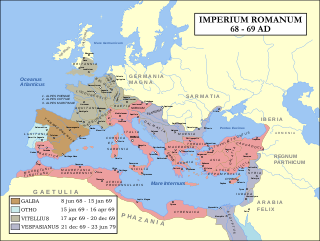Related Research Articles

AD 69 (LXIX) was a common year starting on Sunday of the Julian calendar. In the Roman Empire, it was known as the Year of the consulship of Galba and Vinius. The denomination AD 69 for this year has been used since the early medieval period, when the Anno Domini calendar era became the prevalent method in Europe for naming years.

The gens Calpurnia was a plebeian family at ancient Rome, which first appears in history during the third century BC. The first of the gens to obtain the consulship was Gaius Calpurnius Piso in 180 BC, but from this time their consulships were very frequent, and the family of the Pisones became one of the most illustrious in the Roman state. Two important pieces of Republican legislation, the lex Calpurnia of 149 BC and lex Acilia Calpurnia of 67 BC were passed by members of the gens.
Titus Flavius T. f. T. n. Sabinus was a Roman politician and soldier. A native of Reate, he was the elder son of Titus Flavius Sabinus and Vespasia Polla, and brother of the Emperor Vespasian.
Scribonia Magna, known in modern historical sources as Scribonia Crassi, was a Roman noblewoman. Scribonia was descended from Pompey.
Marcus Licinius Crassus Frugi was a Roman nobleman of consular rank who lived during the Roman Empire. Frugi's mother was an unnamed Roman woman, while his father was consul and governor Marcus Licinius Crassus Frugi. Frugi's adoptive paternal grandfather was consul and general Marcus Licinius Crassus the Younger. Crassus was the grandson of triumvir Marcus Licinius Crassus and the last known direct descendant of his grandfather. He had a daughter called Licinia who married the consul Lucius Calpurnius Piso; their son, Gaius Calpurnius Piso, was a conspirator against the Emperor Nero.
Lucius Vibius Sabinus was a Roman Senator who lived in the 1st century. His daughter Vibia Sabina married the emperor Hadrian.
Lucius Nonius Asprenas was a Roman Senator who was active in the reigns of Augustus and Tiberius. Asprenas was appointed suffect consul to replace Lucius Arruntius on 1 July AD 6.
Aulus Bucius Lappius Maximus was a Roman senator who flourished during the Flavian dynasty; Brian W. Jones considers him one of Domitian's amici or advisors. He held the consulate twice.
Lucius Julius Marinus Caecilius Simplex was a Roman senator who held several posts in the emperor's service. Simplex was then appointed suffect consul in late 101, with Lucius Arruntius Stella as his colleague. His career is primarily known through inscriptions.

Lucius Calpurnius Piso was a Roman senator active in the first century AD. During the Year of Four Emperors he was governor of Africa and supported Vitellius. After the death of Vitellius he was killed by supporters of Vespasian.
Sextus Subrius Dexter Cornelius Priscus was a Roman senator who held several imperial appointments during the reign of Trajan. He is best known for being an acquaintance of Pliny the Younger. Around the year 104 Cornelius Priscus was suffect consul for an as yet undetermined nundinium.

Quintus Pomponius Rufus was a Roman senator active in the imperial service; he was governor during the reigns of the emperors Domitian and Trajan. Rufus was also suffect consul for the nundinium September-December AD 95 as the colleague of Lucius Baebius Tullus. Pomponius Rufus is known primarily from inscriptions.
Aulus Marius Celsus was a Roman senator who held several offices in the emperor's service during the first century AD, as well as playing a role in the Year of Four Emperors. He was suffect consul of the nundinium of July to August 69 as the colleague of Gnaeus Arrius Antoninus.
Lucius Roscius Aelianus Maecius Celer was a Roman senator of the second century. He was suffect consul in the nundinium of November-December AD 100 with Tiberius Claudius Sacerdos Julianus as his colleague. Celer is primarily known from inscriptions.
Quintus Pompeius Sosius Priscus was a Roman senator active in the mid-second century AD, who held a number of offices in the emperor's service. Priscus served as ordinary consul for the year 149 as the colleague of Lucius Sergius Salvidienus Scipio Orfitus. His life is known entirely from inscriptions.
Lucius Nonius Calpurnius Torquatus Asprenas was a Roman senator of the early Roman Empire, who flourished under the reigns of Nero and Vespasian. He was suffect consul around the year 78.
Pompeius Paullinus was a Roman senator, who was active during the reigns of Claudius and Nero. He was suffect consul during a nundinium in either the year 53 or 54. According to Pliny the Elder, Paullinus was the son of Pompeius Paulinus, an eques from Arelate. He may have been the brother of Pompeia Paulina who was the wife of the philosopher and statesman Seneca.
References
- 1 2 Tacitus, Histories , i.14
- ↑ Syme, "Eight Consuls from Patavium", Papers of the British School at Rome, 51 (1983), p. 103
- ↑ CIL III, 7267 = ILS 963
- 1 2 3 "Miscellanea prosopographica", Zeitschrift für Papyrologie und Epigraphik , 42 (1981), pp. 229f
- ↑ Anthony Birley, The Fasti of Roman Britain (Oxford: Clarendon Press, 1981), pp. 4f
- 1 2 Syme, "Eight Consuls", p. 112
- ↑ Tacitus, Annales , xv.18
- ↑ AE 1910, 79 = ILS 9378
- ↑ Morgan, 69 A.D. The Year of Four Emperors (Oxford: University Press, 2006), p. 50
- ↑ Syme, "Eight Consuls", p. 113
- ↑ Tacitus, Histories , i.46
- ↑ Judith Ginsburg, "Nero's Consular Policy", American Journal of Ancient History 6 (1981), p. 68 n. 54